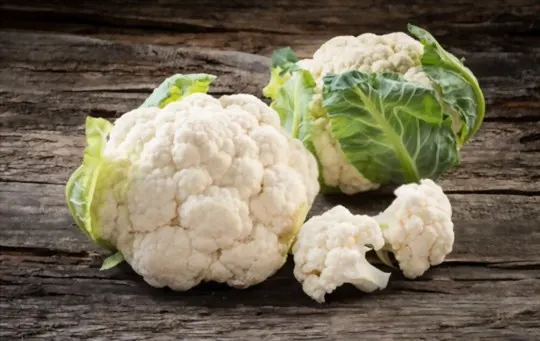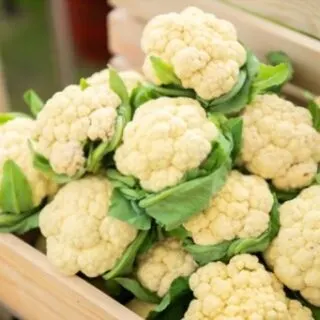Have you ever bought a head of cauliflower from the grocery store and noticed it seemed to start going bad quite quickly?
Well, you’re not alone — many people find themselves wondering exactly how long cauliflower lasts and if there’s anything they can do to extend its life.
In this article, we’ll answer all your questions about storing and buying cauliflower while also offering advice on when to throw it away for safety reasons.
We’ll explain why some heads last longer than others by discussing their texture, shelf-life in different temperatures, and how proper storage can increase both flavor quality and longevity.
Let’s get started!
What’s Cauliflower?

Cauliflower is a member of the cruciferous family of vegetables, which also includes broccoli, Brussels sprouts, and kale.
The cruciferous family is known for its health benefits, and cauliflower is no exception.
This vegetable is a good source of fiber, vitamins C and K, and folate.
It also contains antioxidants that may help protect against some chronic diseases.
It can be eaten raw or cooked. When raw, it has a crunchy texture and a slightly nutty flavor.
When cooked, cauliflower becomes softer and takes on the flavor of whatever it is cooked with.
This vegetable is often used as a low-carb substitute for rice or pasta.
It can also be roasted, mashed, or added to soups and stews.
Cauliflower is a healthy addition to any diet. It is low in calories and fat but high in nutrients.
This vegetable can be enjoyed raw or cooked in many different ways.
How to Store Cauliflower?
Cauliflower is a crunchy, nutritious vegetable that can be enjoyed cooked or raw.
When properly stored, it will stay fresh for up to a week.
The key to storing cauliflower is to keep it dry and refrigerated.
To store cauliflower, first cut off the leaves and any brown spots on the head.
Then, place the cauliflower in a clean, dry bowl or container.
Be sure to leave some space at the top of the container for air circulation.
Store the cauliflower in the refrigerator, and consume within 7 days for best quality.
When cooked, cauliflower can be enjoyed in a variety of dishes, from roasted vegetable medleys to creamy soups.
So don’t let this versatile veggie go to waste – with proper storage, you can enjoy fresh cauliflower all week long.
How Long Does Cauliflower Last?

Cauliflower is a vegetable that belongs to the Brassica oleracea species, which also includes broccoli, Brussels sprouts, and cabbage.
Cauliflower can last anywhere from one to two weeks when stored properly.
To extend the shelf life of cauliflower, store it in the crisper drawer of your refrigerator in a plastic bag or container with holes punched in it.
Avoid washing the cauliflower heads before storing them, as this can cause them to spoil more quickly.
You can also keep cauliflower fresh by wrapping the head in a damp paper towel before placing it in the fridge.
When cooked, cauliflower should be eaten within 3-4 days.
When raw, however, it will only last about a week before starting to go bad.
If you notice any mold on your cauliflower, discard it immediately as this means it has gone bad and could make you sick if eaten.
Can You Freeze Cauliflower?
You can freeze cauliflower, but it’s important to do it properly so that the vegetable maintains its quality.
When freezing cauliflower, you should first blanch it.
Blanching is a process of boiling the cauliflower for a short period of time, then shocking it in ice water.
This helps to preserve the color and texture of the cauliflower.
Once the cauliflower is blanched, you can then place it in freezer bags or containers.
Make sure to squeeze out as much air as possible before sealing the bags or containers.
Cauliflower will last in the freezer for up to eight months.
When you’re ready to use the frozen cauliflower, thaw it in the refrigerator overnight.
You can then cook it as you would fresh cauliflower.
How to Tell If Cauliflower is Bad?

Cauliflower is a versatile vegetable that can be used in many different recipes.
When cauliflower is fresh, it should be white or cream-colored with firm, dense florets.
If you’re unsure of how to tell if cauliflower has gone bad, there are a few key indicators to look for.
The first thing you’ll want to do is check the color of the cauliflower.
If it’s starting to turn brown or yellow, then it’s beginning to spoil.
Another sign that cauliflower has gone bad is if the florets are starting to loosen and fall apart.
The texture of the vegetable will also change as it begins to spoil – it will become mushy and soft instead of firm and dense.
If you see any mold growing on the cauliflower, this is a definite sign that it needs to be thrown out.
Mold can spread quickly and contaminate other foods in your fridge, so it’s best to get rid of moldy produce as soon as possible.
If your cauliflower doesn’t have any visible signs of spoilage but you’re not sure if it’s still good to eat, give it a sniff test.
Fresh cauliflower should have a slightly sweet smell, while spoiled cauliflower will have an unpleasant, sour odor.
If you’re still not sure, err on the side of caution and throw it out – better safe than sorry.
Conclusion
How long does cauliflower last? The answer may surprise you – it can last a lot longer than many other vegetables.
With proper storage, cauliflower can retain its freshness for up to two weeks.
That’s because it’s packed with nutrients and antioxidants that help keep it free from spoilage.
So the next time you’re at the grocery store, don’t be afraid to stock up on this healthy veggie.
It will last longer than you think.

How Long Does Cauliflower Last? Does it Go Bad?
Ingredients
- Cauliflower
- Air-tight containers or Ziplock bags
- Labels and markers
Instructions
- Store your product in an labelled container in a cool, dark place like the pantry or fridge.
- If your food is frozen, allow it to thaw in the fridge before cooking.
- Make sure to look for signs that your food has gone bad before eating it.

Carrie is a food writer and editor with more than 15 years of experience. She has worked for some of the biggest names in the food industry, including Bon Appétit, Food & Wine, and Martha Stewart Living.
As the Editor in Chief of IntroChicago.com, Carrie oversees all of the content on the site. She also manages the team of contributing writers and editors, who help to create delicious recipes, helpful tips, and informative articles that you’ll find on the site.
A native of the Chicago area, Carrie is passionate about all things food. She loves trying new restaurants and experimenting with new recipes in her kitchen. She’s also a graduate of the Culinary Institute of America, so she knows a thing or two about food!
